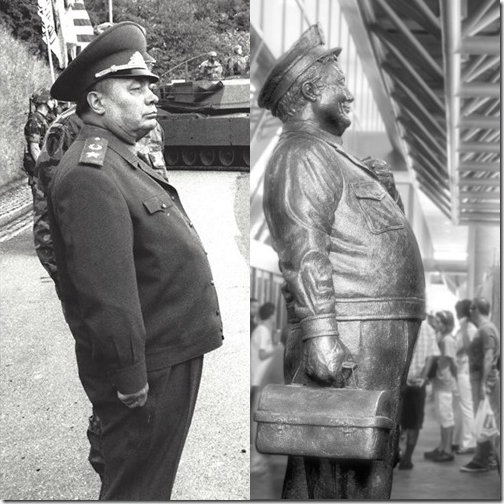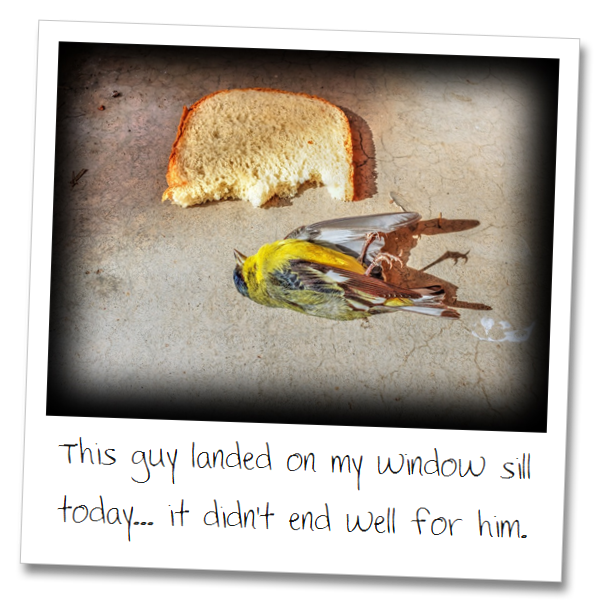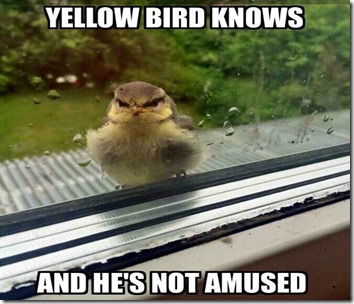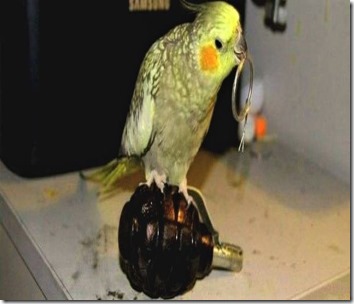The Shrimp of my Father
30 April 2020 • by Bob • Humor
Spanish is more or less the fourth language that I've learned, and recent experience has reminded me that I'm a little out of practice.
I was trying to tell my middlest daughter about Linda Ronstadt's "Canciones de mi Padre" album, but what I said was "Camarones de mi Padre."
While that may be amusing, it just isn't the same...
![]()
Happy Pi Day 2020!!!
15 March 2020 • by Bob • Humor, Music
A couple years ago I created a piece of music for "Pi Day" from the first 256 digits of Pi. I won't bother to go into the details for that experiment, save to say that I simply took the numbers from Pi and added those to a root note of a major scale and let the notes fall where they may. This was a pretty simple exercise, and I'd been kicking around an idea for a much better exercise ever since.
With that in mind, given the proximity to St. Patrick's day, I decided to create a new piece with an Irish feel.
Here's what I did for this experiment:
I chose to use a
However, while I was entering the notes and listening to the playback, many of the notes were often too far apart from their surrounding notes, with very strange octave jumps, which made the whole piece sound random. With that in mind, I decided to use modulus division to cut the range in half, thereby forcing all of the notes into a
This change for my second draft of this experiment resulted in a much smaller scale of
My good friends Randy Clepper (www.randyclepper.com) and Mark Wade (www.markalanwade.com) have taught a lot of classes about Irish ornamentation. I leveraged some of the things that I learned from them, and I added "cuts" to each of the sections where there were two notes that needed to be separated. By way of explanation, a "cut" is when you play a quick grace note above the note that is in the melody line. So if you have a A followed by an A in the melody, you would play the first A of the melody, then jump up quickly and play a B before returning to the second A of the melody, making sure to land the second A of the melody on the beat where it belongs. (Depending on the instrument that you are playing, you would play a cut by playing the first A of the melody, then hit a grace note A before jumping to the grace note B, and returning to the second A of the melody. It's like a really fast triplet.) Once I added the Irish ornamentation throughout the piece, it contributed significantly to the Celtic feel.
The drum beat was another exercise in self-indulgence that was fun to do. Because this entire experiment is about math, I chose to create a "Slip Jig," because they're in a
Lest I forget, the
And last but not least, the 157 bpm tempo that I chose to use was derived from taking 314 (e.g. "3.14") and dividing by 2. ('Cause, you know - more math.)
General Snetkov versus Ralph Kramden
03 March 2020 • by Bob • History, Military, Humor
I've shared on here before about how I had been COL Abrams' translator on the DDR border when GEN Snetkov (the CDR of GSFG in the late 80s) came through. (See https://bit.ly/2PIjcD9 about that.) But something that I don't think I shared here before was how much I thought that GEN Snetkov looked like Ralph Kramden.
English isn't English
28 February 2020 • by Bob • Humor, Travel
A colleague recently reminded me of George Bernard Shaw's famous quote that "England and America are two countries separated by a common language." I have lived through many situations where I have experienced that sentiment firsthand. And with that in mind, I'd like to share a story about a conversation that I had when I was working with the British RAF:
RAF: "You troffing today?"
ME: O_o
RAF: "Yamming?"
ME: O_o
RAF: "Nose-bagging?"
ME: O_o
RAF: "Scoffing?"
ME: O_o
RAF: "Bucking & gagging?"
ME: O_o
RAF: "Are you eating lunch?"
ME: "Yes."
It's a New Year with the Same Warped Sense of Humor
02 January 2020 • by Bob • Military, Humor
I joined the Army in early 1986, at which time the following dark humor marching/running cadence was in prominent use:
A yellow bird / With a yellow bill
Landed on / My window sill
I lured him in / With a piece of bread
And then I smashed / His yellow head
Although to be perfectly honest, the original cadence didn't say "his yellow head;" instead, it used a
Nevertheless, an unfortunate mishap occurred at my house recently: a tiny yellow bird flew into one of my windows, and - tragically - died as a result. However, when I discovered his demise, my first instinct wasn't to clean up the carnage. Instead, I grabbed my camera and a half-piece of bread and took the following picture, which I uploaded to a veterans' group on Facebook with the caption: "This guy landed on my window sill today... it didn't end well for him."
Now at first glance, this might seem rather... morbid. However, my fellow veterans immediately recognized my joke, and they posted comments like the following:
- "His head seems intact. I'm confused."
- "I see you lured him in with a piece of bread."
- "You MUST finish what you started... CRUSH HIS ******* HEAD!!! "
They also replied with images like the following:
One dark example of veteran humor was answered by dozens of darker examples of veteran humor. Once again, this behavior might seem somewhat disturbed to the casual observer, but none of the people involved in the ensuing discussion were sociopaths; most of them were happily married, with great jobs/careers, and selflessly devoted to their kids and grandkids. With that in mind, a short examination of the dichotomy between what veterans might find amusing versus what "acceptable society" might find amusing is worth discussing.
Here is another example of what many veterans find funny:
I have to admit, I literally laughed out loud when I first saw that image; I honestly thought that was one of the funniest cartoons I had seen in a long time. However, when I showed it to my wife, she didn't find it funny. In fact, her comment was, "That's kind of sad..." And as I thought about our different reactions to the same image, I realized why veterans see things differently: we have learned to laugh at death. Not death itself, mind you, but the concept of death. We have to; we'd go crazy if we didn't, and I'll explain why.
The longer you serve in the military, you will eventually have to face death. This will rarely be your imminent demise, although that occasionally happens. But sooner or later you will have to survive the death of a friend or acquaintance, or you will have to come to terms with the fact that what you're doing is likely going to get you killed. Both of those realities are extremely difficult concepts for any sane person to deal with.
In an attempt to deal with the stress of these likely scenarios, most active service members of the military will employ the following coping mechanisms: toxic sarcasm and a dark sense of humor. This may seem strange and/or
When veterans leave the service, their dark senses of humor follow them home; much like having a psychotic ex-lover stalk you across the country. But this is why I love hanging out in the veterans' groups on Facebook: I love seeing that there are others who still see things as I do. My sense of humor may be warped and distorted, but there are others who share that same warped and distorted sense of humor.
In short, other veterans "Get Me." They understand me. They share the same irreverent contempt for death that I do. Or to rephrase a famous idiom, "Fate whispers to the warrior, 'You cannot withstand the storm.' The warrior whispers back, 'You could really use a breath mint.'"
When Your Heroes Grow Old
13 September 2019 • by Bob • Music, Guitar, Humor
I grew up listening to Yes - they were some of my original music heroes, long before I got into bands like Rush. That being said, I am profoundly aware of that fact that as I grow older, my heroes are growing older, too. But some of us aren't aging that gracefully.
Just the other day I saw the following photo of Steve Howe from a recent Yes tour:
I hate to say it, but the first thing I thought of was the Crypt-Keeper from the old Tales from the Crypt television series:
Now that you've seen that, you cannot unsee it. You're welcome.
![]()
![]()
More 511th Stories: Sometimes You Should Shut Up And Be In The Photo
28 August 2019 • by Bob • Military, History
In my last year at Fulda, I was chosen to be the translator for COL John Abrams, (commander of the 11th Armored Cavalry Regiment [ACR]), during a ceremony when GEN Boris Vasilievich Snetkov, (commander of the Group of Soviet Forces in Germany [GSFG]), and GEN Alexandrov (commander of the Soviet Military Liaison Mission in Germany [SMLM]) came across the border.
When the 11th ACR's official photographer for the ceremony heard that I was COL Abrams' translator, he asked if I had a top secret clearance; and if so, was he forbidden from taking my photo. Like many people, I hate having my photo taken, so I told him that it was against regulations to take a photograph of me.
Later on, however, COL Abrams followed up with me and said that I had done a great job as his translator, so he had instructed the photographer to make 8x10 copies of any of the photos from the ceremony for me to keep. (I think you can guess where this is going, even though I didn't at the time.)
The photographer called me when the proofs were ready, and when I showed up at his office, I discovered that he had - in fact - taken photos from dozens of angles, and yet he had managed to faithfully keep me out of every shot. The closest he came to having me in an image was during the
I learned an important lesson from this experience: sometimes you should just shut up and let someone take your
Always Remember to Shave in the Army
20 June 2019 • by Bob • Military, Humor
I attended the USAREUR Air Assault School in 1988, and one of the cadets failed to shave one morning.
He was ordered to dry shave while standing on a stump that was placed in front of the entire class, and he was required to loudly lecture everyone on the merits of daily shaving, while the rest of the class stood at parade rest.
At one point, the following conversation took place:
"Roster Number 30!!! Are you bleeding???"
"Yes, Air Assault First Sergeant!!! Blood helps lubricate the blade!!!"
After which the guy's squad leader was order to kneel next to the stump and catch any blood in his cupped hands, lest any blood hit the ground and desecrate the surrounding area.
Vintage Aircraft Fly-by
11 March 2019 • by Bob • Military
I was driving down the road, and noticed that a B17 was flying past. I thought to myself, "Well, huh. You don't see that every day."
PS - My wife does not share my love of vintage aircraft; she saw this said, "Meh, looks like a plane."
![]()
The Ups and Downs of Illnesses
21 February 2019 • by Bob • Health, Marriage
I've had a cold for a few days now, and as of last night I lost my voice. (My wife, Kathleen, thinks this is an improvement in our relationship.)
Fun fact: when my voice disappears, so does my ability to cough loudly, so I sound like a dog's squeaky toy whenever I have to cough. (It's amazing Kathleen isn't laughing harder at my expense.)
![]()










